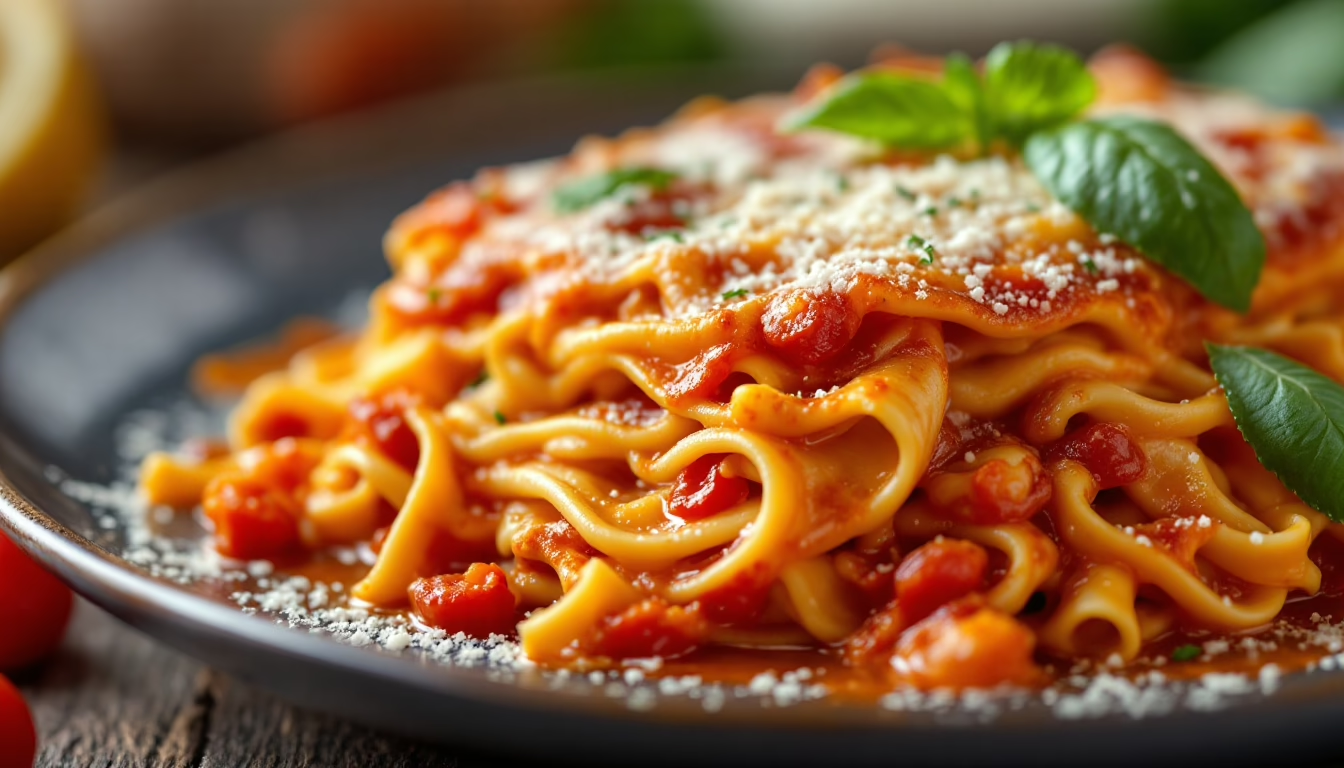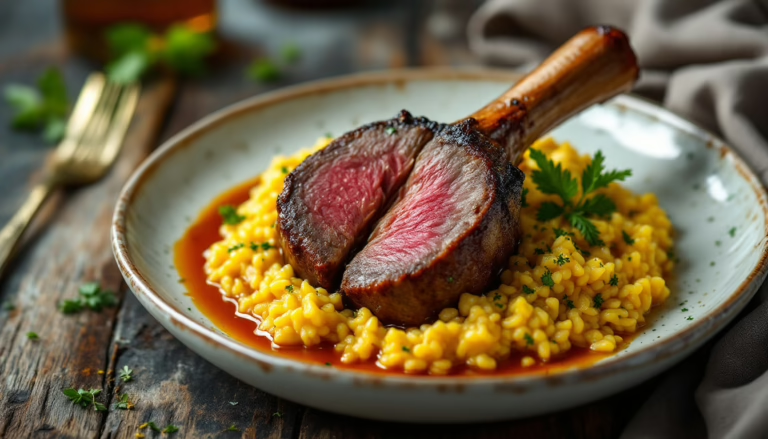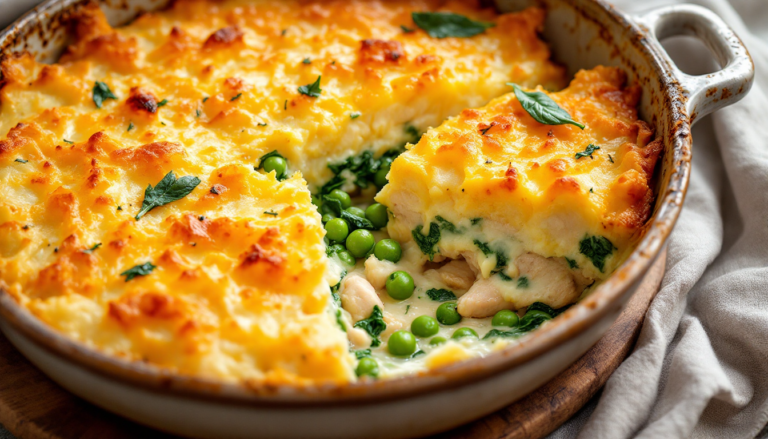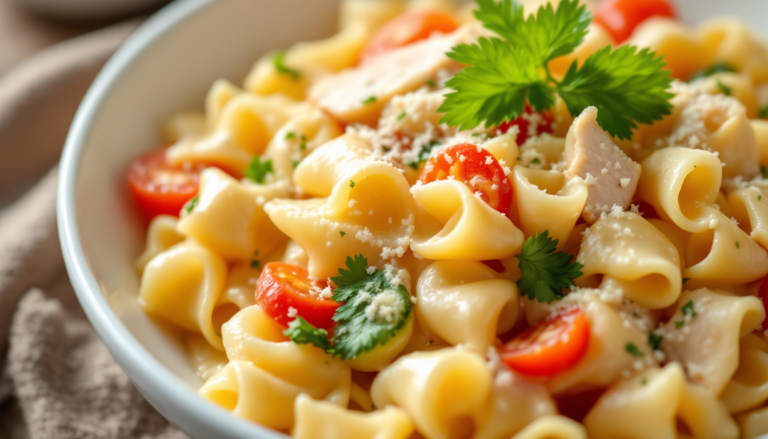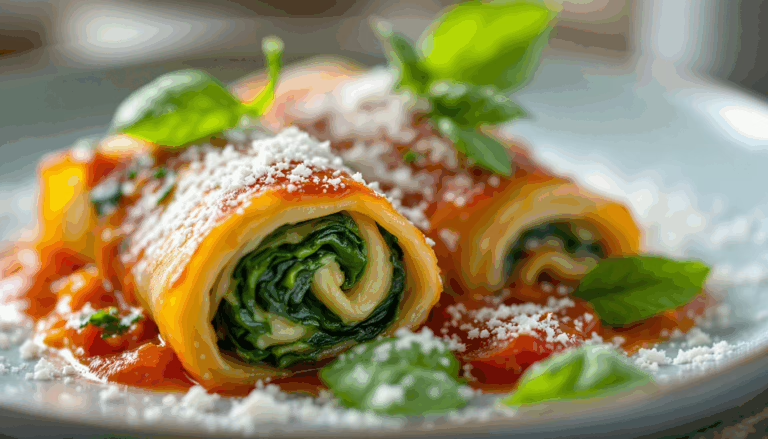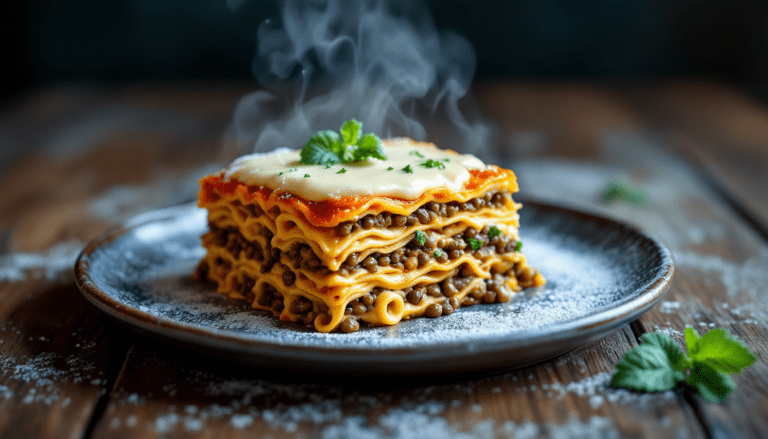Easy Lasagne Recipe | Simple Homemade Italian Dinner
The Lasagne Recipe That Changed My Mind About Everything – I used to be one of those people who firmly believed that lasagne was restaurant food — the kind of elaborate, multi-hour undertaking that belonged in someone else’s kitchen, not mine.
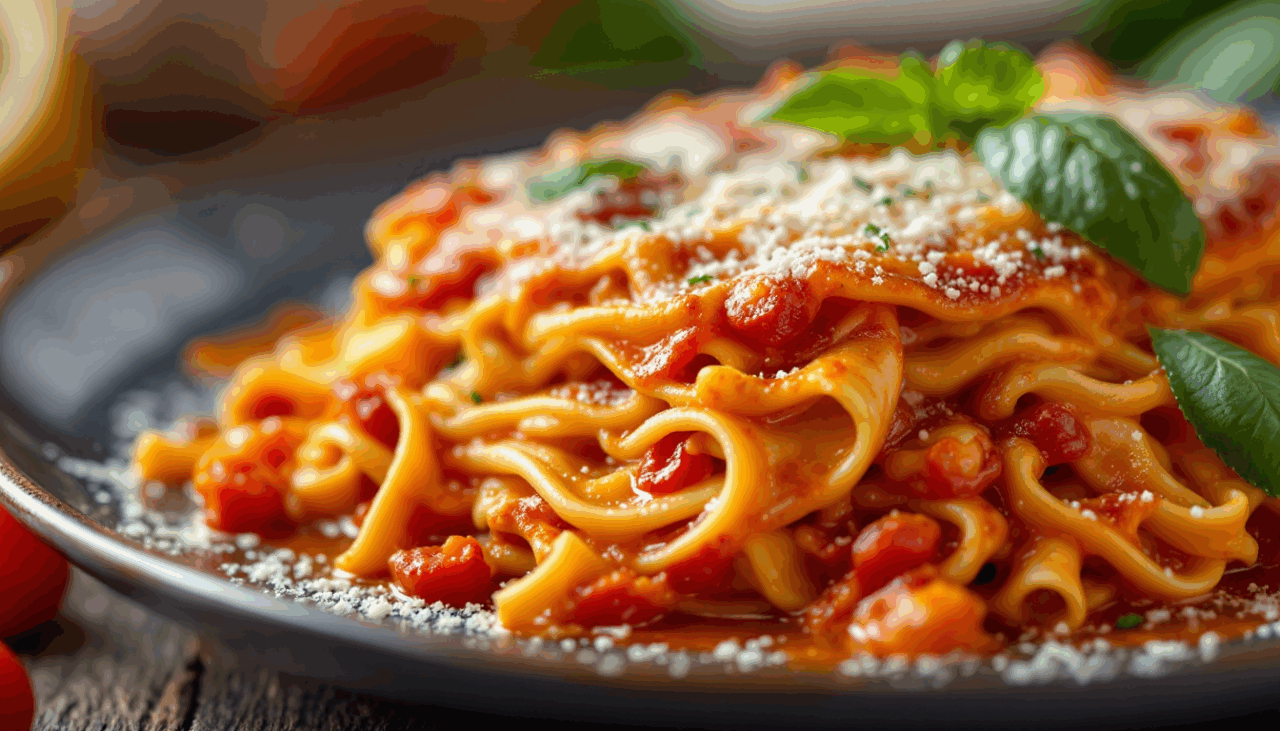
Lasagne
Ingredients
- 1 tbsp olive oil
- 2 bacon rashers
- 1 onion, finely chopped
- 1 stick celery
- 1 medium carrot
- 2 cloves garlic, chopped
- 500g minced beef
- 1 tbsp tomato puree
- 800g chopped tomatoes
- 1 tbsp honey
- 500g lasagne sheets
- 400ml creme fraiche
- 125g mozzarella balls
- 50g parmesan cheese
- Basil leaves for topping
Instructions
- Heat the oil in a large saucepan. Use kitchen scissors to snip the bacon into small pieces, or use a sharp knife to chop it on a chopping board. Add the bacon to the pan and cook for just a few mins until starting to turn golden. Add the onion, celery and carrot, and cook over a medium heat for 5 mins, stirring occasionally, until softened.
- Add the garlic and cook for 1 min, then tip in the mince and cook, stirring and breaking it up with a wooden spoon, for about 6 mins until browned all over.
- Stir in the tomato puru00e9e and cook for 1 min, mixing in well with the beef and vegetables. Tip in the chopped tomatoes. Fill each can half full with water to rinse out any tomatoes left in the can, and add to the pan. Add the honey and season to taste. Simmer for 20 mins.
- Heat oven to 200C/180C fan/gas 6. To assemble the lasagne, ladle a little of the ragu sauce into the bottom of the roasting tin or casserole dish, spreading the sauce all over the base. Place 2 sheets of lasagne on top of the sauce overlapping to make it fit, then repeat with more sauce and another layer of pasta. Repeat with a further 2 layers of sauce and pasta, finishing with a layer of pasta.
- Put the cru00e8me frau00eeche in a bowl and mix with 2 tbsp water to loosen it and make a smooth pourable sauce. Pour this over the top of the pasta, then top with the mozzarella. Sprinkle Parmesan over the top and bake for 25u201330 mins until golden and bubbling. Serve scattered with basil, if you like.
Nutrition
I mean, who has time for all those layers, all that sauce-making, all that… effort?
My weeknight dinners were more like “throw some pasta in a pot and hope for the best” affairs, not the kind of carefully orchestrated productions that lasagne seemed to demand.
But then last winter happened, and with it came one of those weeks where everything felt impossible. You know the kind — where the laundry multiplies like rabbits, the dishes stage a revolt in the sink, and your family looks at you with that particular blend of hope and hunger that makes you want to simultaneously hug them and hide in the pantry.
It was a Tuesday (it’s always a Tuesday, isn’t it?), and I was staring into my refrigerator with the kind of desperation usually reserved for people who’ve been lost in the wilderness for days.
That’s when I spotted them: a package of ground beef that was approaching its use-by date, some sad-looking vegetables that needed rescuing, and — tucked behind the milk — a box of lasagne sheets that I’d bought months ago in a fit of optimism and then promptly forgotten about.
Something clicked. Maybe it was the way the late afternoon light was hitting my kitchen counter, or maybe it was just the realization that I was tired of making the same five dinners on repeat, but I decided right then and there that this was going to be the day I conquered lasagne.
Not the fancy, restaurant-style version with seventeen different cheeses and truffle oil (because let’s be real, who keeps truffle oil in their pantry?), but a real, honest, make-it-work-with-what-you-have lasagne recipe that would actually fit into my actual life.
The Beautiful Simplicity of Classic Lasagne
Here’s what I’ve learned about lasagne in the months since that transformative Tuesday: it’s not actually complicated. It’s just… layered. And there’s a difference.
Complicated means you need special equipment and ingredients you can’t pronounce. Layered just means you do the same simple things several times, building something wonderful in the process.
This particular lasagne recipe comes from the Italian tradition of making the most of what you have — which, coincidentally, is exactly what I was trying to do that day.
It starts with a proper ragù, the kind of meat sauce that gets better the longer it simmers, fills your house with the most incredible smell, and makes everyone within a three-block radius suddenly very interested in being your friend.
The beauty of this approach is that it’s forgiving — if your onions get a little more golden than intended, if you add an extra glove of garlic because you’re feeling generous, if you let it simmer for an extra ten minutes because you got distracted by a phone call — none of that matters. The sauce just gets better.
What makes this lasagne recipe work for real people with real schedules is that most of the heavy lifting happens in that first hour when you’re making the sauce.
After that, it’s just assembly — admittedly, assembly that requires a little finesse, but nothing you can’t handle armed with a good attitude and maybe a glass of wine.
Ingredients for Your Life-Changing Lasagne Recipe
Before we dive into the how, let’s talk about the what.
This isn’t one of those recipes that sends you hunting through specialty stores for ingredients you’ll use once and then forget about.
Everything here should be findable at your regular grocery store, and most of it probably lives in your pantry already.
For the Ragù Sauce:
- 1 tablespoon olive oil (the good stuff, but not the really good stuff)
- 2 slices bacon, snipped into small pieces with kitchen scissors
- 1 medium onion, finely chopped (and by finely, I mean don’t stress if some pieces are bigger than others)
- 1 stick celery, diced
- 1 medium carrot, diced
- 2 cloves garlic, chopped (or pressed, or minced, or grated — whatever works)
- 500g (about 1 pound) minced beef
- 1 tablespoon tomato purée
- 800g (about 28 oz) chopped tomatoes (canned is perfect)
- 1 tablespoon honey (trust me on this one)
- Salt and pepper to taste
For Assembly:
- 500g lasagne sheets (the no-pre-cook kind will save your sanity)
- 400ml crème fraîche (or heavy cream if that’s what you have)
- 125g mozzarella balls, torn into pieces
- 50g Parmesan cheese, grated
- Fresh basil leaves for serving (optional but lovely)
The Step-by-Step Journey to Lasagne Perfection
Now comes the fun part — and I promise you, it really is fun once you get into the rhythm of it. The key to a great lasagne recipe is taking your time with the sauce and then being confident with the assembly.
Think of it like building a delicious, cheesy house: you want a solid foundation, and then you just keep adding floors until you run out of materials or space.
Building the Foundation: The Ragù
Start by heating that tablespoon of olive oil in your largest, heaviest saucepan — the one you use for making soup for a crowd.
While it’s heating, grab your kitchen scissors (if you don’t have kitchen scissors, this is your sign to buy some; they’ll change your life) and snip the bacon into small, bite-sized pieces right into the pan.
There’s something deeply satisfying about this step, like you’re conducting a tiny, meaty orchestra.
Let the bacon cook for just a few minutes until it starts to turn golden and releases some of its fat. This is where the magic begins — that rendered bacon fat is going to be the flavor foundation for everything that follows.
Add your chopped onion, celery, and carrot (this holy trinity of vegetables is called a mirepoix, if you want to sound fancy at dinner parties), and cook them over medium heat for about 5 minutes, stirring occasionally.
You’ll know they’re ready when they’ve softened and the onion has become translucent — not browned, just… mellowed.
Add the garlic and cook for just one more minute, until it smells like heaven and makes everyone in the house ask “What are you making?” in that hopeful way.
The Meat of the Matter
Now comes the beef. Add all 500g at once and break it up with a wooden spoon as it cooks. This part takes about 6 minutes, and your goal is to get it browned all over — not gray, not steamed, but properly browned.
This means resisting the urge to stir it constantly (I know, I know, it’s hard) and letting it actually develop some color.
Once the beef is properly browned, stir in the tomato purée and let it cook for a minute, mixing it well with the beef and vegetables.
This step is crucial — cooking the tomato purée for that minute helps develop its flavor and gets rid of any tinny taste.
The Simmering Symphony
Add the chopped tomatoes, and here’s a neat trick: fill each empty can half full with water, swirl it around to get all the tomato goodness that’s clinging to the sides, and add that to the pan too. Waste not, want not, and all that.
Stir in the honey (this is the secret ingredient that balances the acidity of the tomatoes and makes everyone wonder what makes your sauce taste so good), season with salt and pepper, and bring the whole thing to a simmer.
Let it bubble away gently for 20 minutes. This is not one of those “watch it like a hawk” situations — just give it an occasional stir and let it do its thing. The house will smell incredible, and you’ll feel like a proper cook.
Assembly Day: Building Your Lasagne Masterpiece
Preheat your oven to 200C (180C fan, or 400F for my American friends). While it’s heating, it’s time to assemble this beauty. Grab your roasting tin or casserole dish — something around 23x33cm (9×13 inches) works perfectly.
Start with a ladle of ragù sauce spread across the bottom of your dish. This prevents the pasta from sticking and gives you that crucial first layer of flavor.
Place 2 sheets of lasagne on top, overlapping them to make them fit — don’t worry about perfect coverage, just do your best.
Repeat this process: sauce, pasta, sauce, pasta, building up your layers like a delicious, edible skyscraper. You want to end up with about 4 layers total, finishing with a layer of pasta on top.
The Creamy Crown
Here’s where this lasagne recipe gets really clever. Instead of making a separate béchamel sauce (because who has time for that on a Tuesday?), we’re using crème fraîche thinned with a little water.
Put the crème fraîche in a bowl, add 2 tablespoons of water, and whisk until it’s smooth and pourable.
This creates a lovely, creamy top layer that’s much easier than traditional white sauce but just as delicious.
Pour this mixture over the top layer of pasta, then scatter over the torn mozzarella pieces and sprinkle with the grated Parmesan. The combination of these two cheeses gives you the perfect balance of meltiness and sharp, salty flavor.
The Final Countdown
Slide your lasagne into the oven and bake for 25-30 minutes, until the top is golden and bubbling enthusiastically. You’ll know it’s ready when the edges are slightly crispy and the center is hot all the way through.
Pro Tips for Lasagne Success
After making this lasagne recipe more times than I care to count, I’ve learned a few tricks that make the difference between good and great.
First, resist the urge to cut into it immediately — I know it’s torture, but letting it rest for 10-15 minutes after it comes out of the oven makes it much easier to slice and serve, and the layers won’t slide around like they’re trying to escape.
Second, if you’re making this ahead (which you absolutely can), assemble the whole thing but don’t add the crème fraîche topping until you’re ready to bake.
The cream mixture can make the pasta a bit soggy if it sits too long. You can make the ragù up to three days ahead and keep it in the fridge — it actually gets better after a day or two.
Third, don’t be afraid to customize this recipe to suit your family’s tastes. Hate celery? Leave it out. Want more vegetables? Add some diced zucchini or bell peppers to the ragù.
Vegetarian household? Swap the beef for lentils or mushrooms. The technique stays the same; the ingredients can flex to fit your life.
Finally, invest in good-quality canned tomatoes — they make a real difference in the final flavor. San Marzano tomatoes are lovely if you can find them, but any high-quality canned tomatoes will work beautifully.
Variations to Keep Things Interesting
Once you’ve mastered this basic lasagne recipe, the world of variations opens up before you like a delicious, cheesy map of possibilities.
Try adding a layer of ricotta mixed with spinach for extra richness and nutrition. Or swap out half the beef for Italian sausage for a different flavor profile.
For a lighter version, you can use turkey mince instead of beef, or even try a combination of mushrooms and lentils for a vegetarian twist that’s surprisingly satisfying.
One of my favorite cold-weather variations involves adding a pinch of cinnamon and a bay leaf to the ragù — it adds this warm, complex note that makes people think you’ve been cooking all day even when you haven’t.
And for summer, try adding fresh basil to the ragù and using buffalo mozzarella instead of regular mozzarella for an extra-indulgent version.
The Real Talk: What to Actually Expect
Let’s be honest about what this lasagne recipe will and won’t do for you. It won’t make itself (unfortunately), and it’s not a 30-minute meal — you’re looking at about an hour of active cooking time, plus another 30 minutes in the oven.
But here’s what it will do: it’ll fill your house with the kind of smell that makes neighbors suddenly very friendly, it’ll feed your family a proper, satisfying dinner, and it’ll give you leftovers that are somehow even better the next day.
The first time you make it, you might feel a bit overwhelmed by all the steps, but I promise that by the second or third time, you’ll find your rhythm.
You’ll develop your own little shortcuts and preferences, and before you know it, you’ll be the person people ask for lasagne recipe advice. And that, my friends, is a pretty good feeling.
This isn’t restaurant-perfect, Instagram-worthy lasagne — it’s better. It’s real-life, made-with-love, feed-your-people lasagne.
The kind that says “I care enough about you to spend an hour making dinner,” the kind that creates memories and fills bellies and makes everyone at the table happy. And really, what more can you ask from a Tuesday night dinner?

